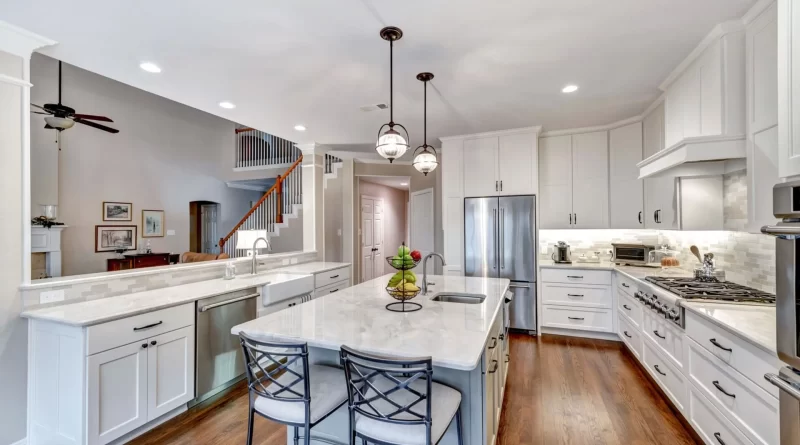Revolutionizing Your Kitchen Space Innovative Flooring Styles and Design Tips
The heart of the home deserves a foundation that stands the test of time while reflecting the personality and style of its occupants. Innovative kitchen flooring is not just about choosing a material that looks good; it’s about finding a solution that combines aesthetics, functionality, and sustainability. This section delves into the latest trends in kitchen flooring, exploring how advancements in materials and technology have broadened the horizons for homeowners and designers alike. From the resurgence of classic materials with a modern twist to the introduction of entirely new, eco-friendly options, the landscape of kitchen flooring is evolving. We’ll discuss how these innovations are not only changing the way kitchens look but also how they feel underfoot and how they contribute to the overall atmosphere of the home. Additionally, this part will highlight the importance of considering factors such as durability, ease of cleaning, and resistance to moisture when selecting the perfect flooring for your kitchen.
The Rise of Eco-Friendly Materials
In recent years, the push towards sustainability and eco-conscious living has made a significant impact on home design, particularly in the choice of kitchen flooring. Homeowners are increasingly drawn to materials that are not only durable and stylish but also environmentally friendly. This shift has led to the emergence of innovative flooring options that prioritize green living without compromising on design.
Bamboo and cork have become popular for their renewable qualities, with bamboo growing rapidly and cork being harvested from the bark of trees without harming the tree itself. Both materials offer a unique aesthetic appeal, warmth, and comfort underfoot, making them ideal for the kitchen. Furthermore, recycled materials are also making their way into kitchen floors, including recycled wood, glass tiles, and even rubber, offering a plethora of choices for eco-conscious homeowners.
Manufacturers are also adopting greener practices, producing low-VOC (volatile organic compounds) adhesives and finishes, which contribute to healthier indoor air quality. These eco-friendly materials not only help in reducing the carbon footprint but also add a story of sustainability to your home.
This section explores the benefits and considerations of selecting eco-friendly flooring materials, including their impact on the environment, their lifespan, and how they can contribute to creating a healthier home. It also touches on the aesthetic versatility of these materials, which can complement any kitchen design, from modern to rustic. The rise of eco-friendly materials in kitchen flooring represents a step forward in sustainable living, offering homeowners a way to make a positive impact on the environment while achieving their design goals.
Embracing Color and Pattern
The modern kitchen is no longer just a space for cooking but a central hub for family gatherings, entertainment, and expression of personal style. As such, homeowners are becoming more adventurous in their design choices, particularly with flooring. Embracing color and pattern in kitchen flooring is a trend that’s gaining momentum, offering a vibrant alternative to traditional neutrals.
Colorful tiles, bold patterns, and even mixed-material floors are transforming kitchens into dynamic spaces that reflect individuality and creativity. Geometric patterns, intricate designs, and a wide spectrum of colors enable designers and homeowners to create a focal point on the floor, adding depth and character to the kitchen.
This trend is not limited to tiles alone. Technological advancements in manufacturing have allowed for vinyl and laminate flooring to offer a wide range of designs, from realistic wood and stone effects to abstract patterns and bright colors. These materials offer the added benefits of durability and ease of maintenance, making them ideal for busy kitchens.
Moreover, incorporating color and pattern into kitchen flooring allows for more freedom in the rest of the kitchen’s design. A bold floor can be balanced with more subdued tones on the walls and countertops, or it can complement and enhance the color scheme of kitchen cabinets and accessories.
This section will explore how to effectively incorporate color and pattern into your kitchen flooring, including tips on balancing bold floors with the overall kitchen design, choosing the right materials for durability and maintenance, and how to use flooring to make a statement or unify the room’s aesthetic. Whether you’re drawn to the charm of vintage-inspired tiles, the warmth of richly colored wood, or the modern appeal of patterned vinyl, embracing color and pattern can make your kitchen truly one-of-a-kind.
The Durability Factor: What You Need to Know
When it comes to kitchen flooring, durability isn’t just an option; it’s a necessity. The kitchen is a high-traffic area subject to spills, stains, and constant wear and tear. Therefore, selecting a flooring material that can withstand these challenges is crucial for any homeowner. This section explores the durability factor of various innovative kitchen flooring options, providing insights into how they stand up to the rigors of daily kitchen activities.
Hardwood flooring has long been a favorite for its timeless appeal, but not all wood is created equal. Hardwoods like oak, maple, and cherry are more durable and resistant to dents and scratches, making them suitable for kitchens when properly sealed and maintained. Engineered wood offers a similar aesthetic with added moisture resistance, making it a viable option for the kitchen environment.
Tile, whether ceramic, porcelain, or stone, is renowned for its durability and ease of maintenance. Porcelain tiles, in particular, are highly resistant to scratches, stains, and moisture, making them ideal for the kitchen. With advancements in technology, ceramic and porcelain tiles can now mimic the look of natural stone or wood, offering durability without compromising on style.
Luxury vinyl tile (LVT) and laminate flooring have emerged as cost-effective, durable options for kitchens. These materials can replicate the look of natural materials while offering superior resistance to moisture, stains, and wear. LVT, especially, has gained popularity for its ability to stand up to kitchen challenges while providing a comfortable underfoot feel.
Concrete and epoxy flooring are other durable options that offer a modern, industrial look along with exceptional longevity and resistance to moisture and stains. These materials can be customized with colors and finishes to suit any kitchen design.
In this section, we’ll delve deeper into the importance of considering the durability factor in kitchen flooring choices, including tips on maintenance and how to select the best material for your lifestyle and kitchen’s demands. Durability doesn’t mean sacrificing style; with the right choice, you can ensure your kitchen flooring is both beautiful and built to last.
Conclusion: Crafting Your Ideal Kitchen Space
Revolutionizing your kitchen space with innovative flooring styles and design tips is an exciting journey that blends aesthetics, functionality, and technology. As we’ve explored, the possibilities are vast, from eco-friendly materials that contribute to a healthier planet to smart flooring solutions that offer comfort and convenience. Embracing color and pattern can inject personality and vibrancy into your kitchen, while understanding the importance of durability ensures that your chosen flooring stands up to the rigors of daily use.
The key to crafting your ideal kitchen space lies in considering not just the visual impact of your flooring but also its practical implications. Eco-friendly options such as bamboo, cork, and recycled materials offer sustainability without sacrificing style. The advent of smart flooring technologies, such as in-floor heating systems and materials with health benefits, represents the future of kitchen design, where comfort and functionality are paramount.
Ultimately, the choice of kitchen flooring should reflect your personal style, lifestyle needs, and environmental values. Whether you’re undertaking a full renovation or simply refreshing your space, innovative flooring solutions can transform your kitchen into a place of beauty, comfort, and sustainability. Remember, the perfect kitchen is not just about how it looks but how it feels underfoot, how it contributes to your home’s health, and how it fits within the broader context of your life and the environment.
In closing, the journey to your ideal kitchen space is an opportunity to make choices that align with your values, meet your practical needs, and express your unique aesthetic. With the right planning, research, and creative thinking, you can create a kitchen that not only looks fantastic but also enhances your home and lifestyle for years to come.

